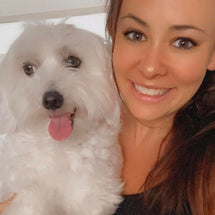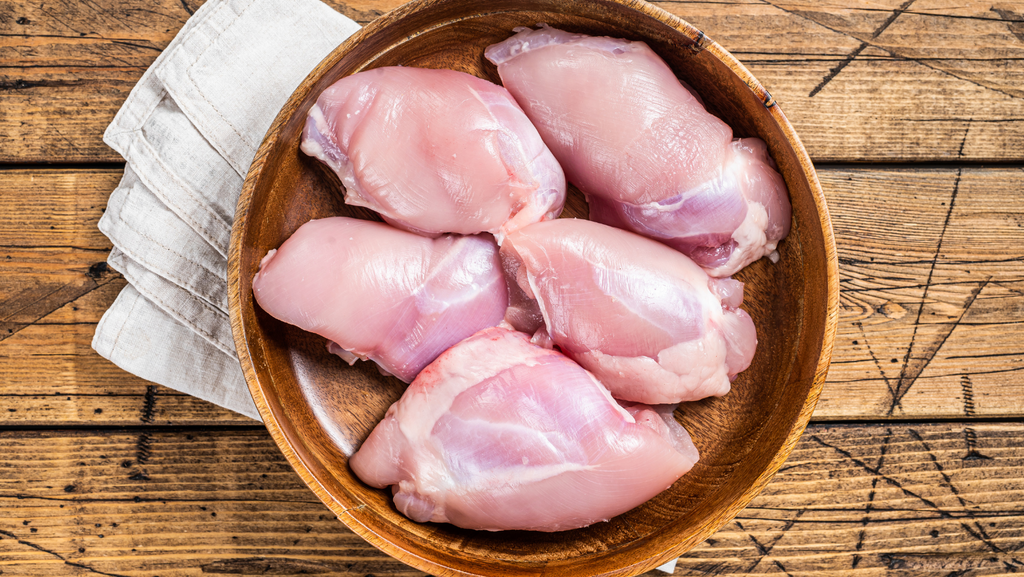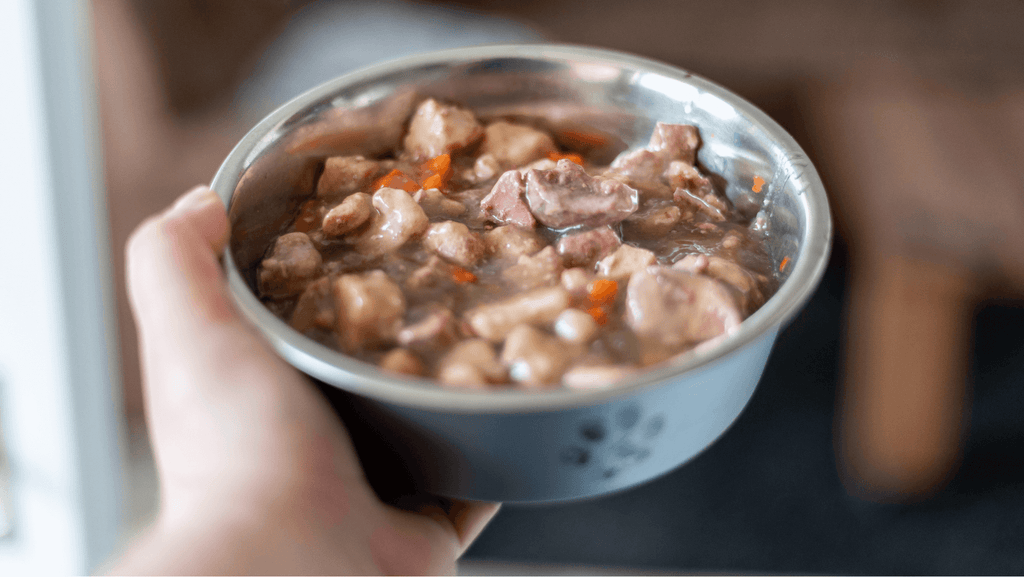How Much Food Does a Dog Need on a Raw Diet?

A lot of dog owners have transitioned the diet of their pet from kibble to raw diet for various health benefits. After all, we want to ensure our canine companions live healthy and happy lives. You may be one of these people who have decided to make the change and are looking for pointers on raw feeding. One of your first questions then might be: how much food does a dog need on a raw diet?
Before we delve into the specifics of the diet, here are few starting things about raw food feeding that beginners should understand.
What is Raw Feeding for Dogs
The dog raw diet food, often referred to as BARF (Biologically Appropriate Raw Food or Bones and Raw Food), involves feeding dogs a diet that consists primarily of raw meat, bones, fruits, and vegetables. This type of diet aims to mimic what a dog’s ancestors would have eaten in the wild and is based on the belief that raw foods are more natural and beneficial for canine health compared to commercial kibble.

Components of a Raw Diet
Often you will here about the 80-10-10 rule— meaning your dog should consume a ratio of 80% meat, 10% bone, and 10% organ to mimic the proportions of prey animals.
To take it one step further we like to include additional vegetables, fruits and supplements to ensure your dog is receiving a complete and balanced diet rich in essential vitamins and minerals.
- Muscle Meat: About 70-80% of the diet (e.g., chicken, beef, turkey).
- Raw Edible Bones: About 10-15% of the diet (e.g., chicken wings, necks).
- Organ Meat: About 10% of the diet (e.g., liver, kidney).
- Vegetables and Fruits: About 5-10% of the diet (optional and depending on the diet plan).
- Supplements: As needed to ensure nutritional balance (e.g., fish oil for omega-3s).
Health Benefits of a Raw Diet
- Leaner, more muscular build
- Healthier skin and coat
- Better dental health: cleaner teeth and fresher breath
- Increased energy
- Smaller stools
- Reduction in allergies
How Much Food Does a Dog Need on a Raw Diet?
Switching a dog from dry kibble to a raw food diet can be a challenging process, including knowing just how much to feed your pet. Often if you are buying raw food from a company they will give you feeding guidelines, but if you are making your own, its important to consider a few things!
Its also important to keep in mind, you will likely notice that you are feeding a lot more in quantity due to the increased moisture content.
Key Considerations When Switching from Kibble to Raw Food
-
High Moisture Content:
- Kibble: Dry kibble typically contains about 10% moisture.
- Raw Diet: Raw food, on the other hand, contains around 70-80% moisture.
-
Impact: Due to the high moisture content in raw food, the volume of food needed will appear larger compared to the relatively small volume of dry kibble. This can be misleading when determining the correct portion sizes.
-
Nutrient Density:
- Kibble: Commercial kibble is often calorie-dense and highly concentrated, meaning dogs consume smaller quantities to meet their nutritional needs.
- Raw Diet: Raw food is less calorie-dense on a per-weight basis due to the higher water content and natural ingredients, requiring larger portions to meet the same caloric needs.
-
Impact: It's essential to adjust feeding amounts based on nutrient density, ensuring that dogs receive adequate energy and nutrients from the raw diet.
-
Caloric Content:
-
Kibble: The caloric content is often clearly labelled, making it easier to measure and portion.
-
Raw Diet: Calculating caloric content can be more complex due to variability in raw ingredients and homemade recipes.
-
Impact: Understanding the caloric needs of your dog and how they translate into raw food portions is crucial for maintaining a balanced diet.
General Feeding Guidelines
Puppies:
- 2-3 Months Old: 8-10% of current body weight.
- 4-6 Months Old: 6-8% of current body weight.
- 7-12 Months Old: 4-6% of current body weight
Puppies require more frequent feeding, typically 3-4 times a day initially, gradually reducing to 2-3 times a day as they approach one year old.
E.g. a 4.5kg puppy that is 4 months old you would feed 7% of their body weight.
Calculation: 4.5 kg x 0.07 = 0.315 kg (315 grams) of raw food per day.
Adult Dogs:
-
2-3% of Body Weight: Adult dogs typically need between 2% and 3% of their body weight in raw food per day. The exact amount can vary based on the dog's activity level and metabolism.
- Less Active Dogs: Closer to 2% of their body weight.
- More Active Dogs: Closer to 3% of their body weight.
E.g. a 22.7kg adult dog with a moderate energy level, you would feed 2.5% of their body weight.
Calculation: 22.7 kg x 0.025 = 0.5675 kg (567.5 grams) of raw food per day
Senior Dogs:
- Senior dogs might need adjustments based on their health, activity level, and metabolism. Often, 2% of body weight is a good starting point.
E.g. a 18kg senior dog, you would feed3 2% of their body weight.
Calculation: 18 kg x 0.02 = 0.36 kg (360 grams) of raw food per day
For a balanced diet packed with nutrients and tailored to different life stages, consider options like roo’s Clues with SUPERFO0D EXTRAS 10.8kg—designed to support energy, immunity, and overall wellness with natural superfood ingredients.

Raw Food Feeding Tips and Reminders
Feeding your dog a raw food diet can offer numerous benefits, but it requires careful planning and attention to detail to ensure your dog receives a balanced and nutritious diet. Buying raw food pre-made diet is always a good way to take any guess work out of it all, and can save you some effort, but if you are choosing to make your own food for dogs (which can save you some money) we have some tips and reminders to help you successfully transition your dog to an appropriate and balanced raw diet.
Some key points to remember when creating a balanced raw food dog diet are:
- Start slowly by mixing small amounts of raw food with their current food, gradually increasing over 7-10 days. Ensure the diet includes the right proportions: 70-80% muscle meat, 10-15% raw edible bones, 10% organ meat, and 5-10% vegetables/fruits.
- Never feed cooked bones of any type. Bones, when cooked, may splinter and pierce the stomach or intestines.
- Raw meat can contain bacteria like Salmonella and E. coli, so maintain high standards of cleanliness and consider freezing meat before feeding. Puppies and senior dogs have different nutritional needs, requiring adjustments in portion sizes and diet based on their growth stage or health conditions.
- Avoid harmful foods such as onions, chocolate, grapes, and raisins.
So, How Much Raw Meat Should I Feed My Dog?
An adult dog should eat 2-2.5% of their body weight in raw meat per day, while older, less active, or overweight dogs should consume 1.5% of their ideal weight. Smaller breeds often require a higher percentage (around 4%), while larger dogs might do well with 2%. Keep in mind that the exact amount varies with your dog's size, activity, age, and overall weight.
As always, it is best to discuss your pet’s diet with your veterinarian first.

Wondering where you can get delicious and ethically-sourced raw dog food delivered to your doorstep? Contact us and we'll help you get the best raw food there is for your pup.





